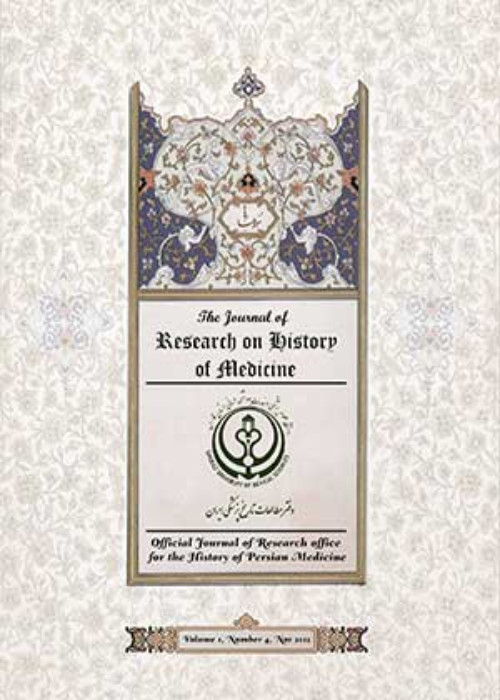فهرست مطالب
Journal of Research on History of Medicine
Volume:3 Issue: 1, Feb 2014
- تاریخ انتشار: 1392/12/14
- تعداد عناوین: 7
-
-
Page 3From the historical and medical point of view, this paper purports to illustrate two motifs of Immaculate Conception in Christian art. The first painting is an altarpiece of unknown author from the 17th or 18th century, known as Our Lady of Conception in the church of St. Antony the Abbot in the city of Rab on the island of the same name in Croatia, and the other is a mural from 1490, Mary’s Annunciation of John from Kastav in the Holy Trinity Church in Hrastovlje, Slovenia. This review ends with the conclusion that Christianity, with the accompanying iconography, other than sending just a religious message, if properly perceived, may also encourage the believer to a series of practical, in this case, biological thoughts on conception, i.e. the beginning of life.
-
Page 11Using Nigella sativa L. (Black cumin), in traditional medicine, dates back to Tutankhamen, the pharaoh of Egypt. There are aboundant historical and religious evidence implying the importance of these curative seeds. Traditionally, they have been used for various therapeutic purposes. Zokam and Nazleh (ZaN) are two nasal diseases used to be treated by these medicinal seeds. Traditional Persian Medicine (TPM) classifies each of these diseases into warm and cold types. Comparing symptoms, Warm ZaN resembles Allergic rhinitis and cold ZaN is similar to Rhinosinusitis. Many documents have been found in TPM references that explain different ways for preparing Black cumin seeds for the treatment of cold ZaN, but there is no evidence for treating warm ZaN. In recent years, many original articles have been written to explain the therapeutic qualities of these curative seeds. They exhibit that Black cumin seeds, in addition to increasing the mucociliary clearance, histamine release inhibition and antihistaminic effects, have anti-inflammatory, antibacterial, antibacterial biofilm formation. Consequently, they confirm the application of Black cumin in the treatment of rhinosinusitis or cold ZaN.
-
Page 21Islamic Golden Age, 9-12 century AD, was the period through which Persian scientists and physicians were most influential in improving medical sciences including cardiovascular knowledge. Although post-Islamic Golden Age witnessed a number of great Persian scholars moving cardiovascular concepts forward, they failed to become as well known as their predecessors. One of these scholars was Hakim Mohammad Azam Khan belonging to the 19th century. He authored many books on medical sciences. He wrote all the books in Persian. Some of his most famous works are Eksir Azam (The Greatest Elixir; a comprehensive medical encyclopedia); Romouz Azam (The Greatest Secrets; a general book on medicine) and Qarabadin Azam (Pharmacopeia). In addition, he had a valuable treatise on pulsology, named Naiier Azam. Naiier Azam, one of the important works on cardiology in Persian medicine, which includes three parts: one introduction and two teaching chapters (Taelim).
-
Page 25The human knowledge on orthopedics traces back to dawn of the medical history. During the history of medicine, several scholars including Persian scientists investigated orthopedics and contributed to its flowering. Abu Ali al-Hussain ibn Abdullah ibn-Sina is a great Persian physician whose opinions on various aspects of medicine, including the science of orthopedics, are so remarkable. In this paper, we will review Avicenna’s viewpoints and recommendations for diagnosis, care and treatment of different bones fractures which can be representative of the early knowledge on orthopedics in Persia.
-
Page 37Allama Qutb al-Din Shirazi, is one of the elders and luminaries of Iran and the Islamic world and one of the great characters in the history of science in the world. Despite of the popularity of Allameh Qutb al-Din in medicine, he had reached to a degree of scientific development in different fields of science, literature, art and even folk art that he can be cited as an expert in that field. Allama Qutb al-Din was so capable and diligent in mathematics, astronomy and geometry, in poetry, literature, mysticism and philosophy, in the art of calligraphy and even in public art like theatrics and magic.The existence of all of these capabilities in a single person, expresses the inherent genius more than anything else, but besides this intelligence and ingenuity, the time and the period in which that person lived, must be considered. In discussing the issue of period, the place where the person lived in is important. Shiraz, as one of the most important cultural centers of Iran, is the birthplace of many great persons in the history that one of the most important features of the scientific character in some of them, is multidimensionality, people who sometimes accompanied their scientific expertise with artistic and literary elegance and other fields of knowledge.In this paper, in addition to a brief review of life of Allameh Qutb al-Din Shirazi, the impact of the cultural atmosphere of Shiraz on his character and also his multidimensional character are being analyzed.
-
Page 43During the human history, there was a great struggle against illness and pain, and physicians have always been vanguard in this fight, but some physicians, in addition to treating patients, have been doing their actual duty, namely the maintenance of human health. In the ancient medical history resources, issues of health protection have been shown to be one of the most significant subjects of medical science. Naseri’s view on health maintenance is one of medical resources, in which principles of health protection have been expressed, entitled “setteye zaroorieh”. The following literature is an overview of Iranian knowledge in the field of preventive medicine and Old Iranian physician’s attention to this important issue.Undoubtedly, similar studies can provide new incentives for modern physicians to address this medical field and may help to achieve health promotion goals and also can reduce excessive costs of health care and increase the life expectancy in communities.


